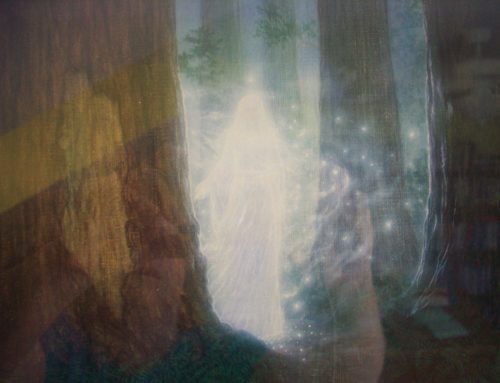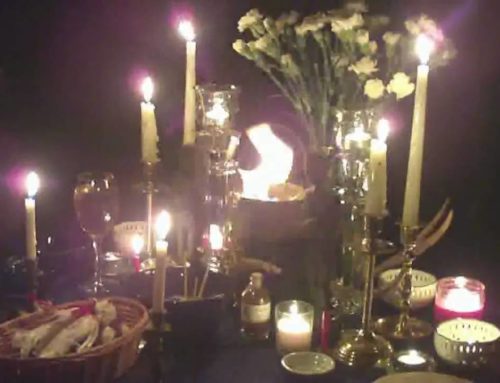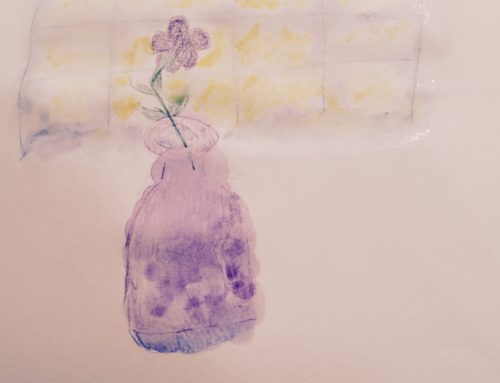The Light Returning
From Yule to Imbolc darkness reigns until we notice the returning of the light. The fires of Imbolc signified both the fire of fertility within Earth and the fires of the sun. The nights gradually shorten and the days gradually lengthen. Bonfires and candles were used in rituals as magical encouragement of the sun. Candles were left burning in window all night or carried in procession to mark this seasonal passage.
Imbolc, is known by many names in different cultures – Oimealg, Candlemas Day, GroundHog Day, La Fheile Bride (Ireland), Gwyl Mair Dechraur Gwanwyn (Wales), Laa’L Bresshey (on the Isle of Man), Goel Dantolyon (Brittany).
The word Imbolc is thought to mean “the milk of ewes” (occurring about a month before the lambing season) but it may also come from i mbolg meaning “in the belly”.
However, some think that perhaps the name is connected to the Irish word imb-fholc, which means “washing oneself”. The Celts considered this a day of purification and purification by lustration, where the hands, feet, and head were washed at Imbolc to consecrate them for the new upcoming cycle of work, was a basic part of Celtic ritual. In the Christian Calendar Imbolc coincides with Candlemas, the Feast of the Purification of the Virgin.
A Time of Quickening
Imbolc is a time when Earth’s energies are beginning to awaken. It is a good time for initiations, planting the seeds of thought and potential you want to begin to nourish, and clearing out clutter on all dimensions to make way for the new. The rituals and celebrations of Imbolc focus on the central theme of increase in the material as well as the immaterial realm. The festivals and blessings empower both the Land and the Tribe tying them together as one and remind us that all increase is derived from the one same divine, energetic source.
Imbolc is the festival of emerging from Winter hibernation – the first ploughing, first plantings, and first fires. It is a festival marking the recognition that the flow of milk from Earth Mother has begun again and will nourish us with its love and light. It is a time of honoring the stirrings of the return of life in the midst of winter where we focus on renewal and becoming ready to throw off the heavy coats of winter.
It is noted in many cultures as the festival of the lactating ewes. It marks the half-way point in the journey from the Dark Half of the Year into the Light Half of the Year at Beltane. Imbolc represents the time when many streams of life are reinvigorated in the land and is a celebration of Holy Waters and Sacred Fires. It is a time when the rekindling of the fires of Earth give life to plants and animals.
Forest animals begin mating rituals. Serpents begin awakening in their lairs. Sap begins to flow. Seeds burst open and the first of the spring flowers sprout up from the ground.
Renewed Hope
As the light returns at Imbolc we experience hope at the possibility of renewed life. As the days slowly lengthen new plants grow. New manifestations emerge from their Spirit form. The reawakening of the fertility in the land and the beginning of new cycle of agriculture in the Tribe were united in the honoring of the creative force that brought life and movement. Purification with Water, the displays of Fire, and the making of Talismans were the central focus of rituals used to honor this power.
Imbolc Celebrations and Festivities -Which Imbolc Magical Crafting Calls to You?
Imbolc is a time of celebrating the first thaw of winter and the anticipation of the return of Spring.The first week of February typically marks the first – though temporary – thaw and the first ploughing would take place.
A decorated plow – was brought door to door and was followed by children asking for gifts and money. The plough was a symbol of the emergence of Imbolc and was honored with the “Water of Life” (whiskey) and offerings of food left on it for the nature spirits. Agricultural tools were consecrated and the fires of blacksmiths (potent magic and directly under the auspices of Brigid) were blessed by a woman acting on the Goddess Brigid’s behalf. The Winter Greens that were brought into the house at Winter Solstice were burned.
At Imbolc Bridid’s crosses – made of wheat were given as charms to protect the home and bring good luck. The whole family participated in the making of these crosoga that would be hung in the home or placed in windows.
Banal Bride– To welcome Bridget into the household and obtain her blessings, the eldest daughter of each household would assume the personage of Bridget, gather rushes and go through the house blessing the home, food and drink, and the hearth. Rushes might be left by the fire overnight and covered by a white cloth as a Bride’s Bed inviting the Goddess to sleep there overnight and transferring her healing strength to the rushes. These rushes were used for healing work throughout the rest of the year. Or the rushes were used by the family to make crosoga which would be blessed and used for protection in the house.
Corn dollies (straw brideoga) – were traditionally made from oat or wheat, dressed and carried- as the Banal Bride and Bride’s company of maidens – door to door by young girls on Imbolc Eve to bless each household. The maidens would be given food and drink and a small gift given to the “bride” in return for blessings of good luck. The women who held the dolls were expected to be a mirror of Brigid.
The tradition of making dolls in the image of the Goddess is an ancient tradition. Traditionally, they are made from the previous years’ harvest and would be fashioned with additional ribbons, charms, and other decorations. At times a traditional Bridie Cross made from reeds would be attached to her heart and she would be given a White Wand- BarragBride -made from white birch, willow, or hazel symbolizing Her quickening fiery energy. The Bridie Doll is returned to Earth around the Spring Equinox once the grains begin to grow.
Bride’s Beds – The older women of the community made “bride’s beds” or cradles for the corn dollies to sleep in and magic wands for them to hold. In the morning if the magic wand had made a mark in the ashes in the hearth it was considered a sign of good luck. Special cakes were baked and there was feasting and dancing for all.
Bridget’s mantle (Healing Cloth) – Families would leave a mantle- brat Bride or Bridget’s mantle (Healing Cloth) – outdoors or in a window – on the eve of Imbolc to be blessed by Brigid on the morning of Imbolc. This mantle would then be used during the year to cover the sick. Strips of the mantle would be cut and tied to a sick person or animals to help in their healing. In another manner, the same mantle would be renewed year after year to absorb the power of the Goddess/Saint to be used for protection and in healing rituals. It was believed that it took seven years for a brat Bride to attain its full curative powers.
A crios bride (Brigid’s Belt)– which is a hoop of straw with four solar crosses tied to it was carried from home to home and men would step through it sideways beginning with the right foot, and women lower it over their heads and step through it three times to mark their ritual rebirth through the birth canal of the Land Goddess – Brigid.
Bridie Crosses (crosoga)– the Star of Bridie- were made at Imbolc from reeds, wheat or barley. They were twisted into the shape of a swastika, which- before it was corrupted by the Nazis- represented the sun with its rays pointing in four directions. It symbolized the certainty that the light and summer would always return.
Bridie Eyes – were made by creating an equal arm cross from two sticks and then weaving colored wools around them. They were used as protection against evil and hung in barns and houses to protect the people and the livestock.
The figure called “the Sun, the Moon, and the Stars” made from strips of peeled rush-stems taken from those used to make crosoga were pasted onto a board in the form of a disk, a half of a disk, and four seven rayed stars, and a ladder with three rungs. This was displayed with the crosoga.
Imbolc to Beltane
From here on out until Beltane we focus on continued strengthening of the Light and the encouragement of growth and activity.
“The Land Goddess’ fire has been kindled, the blaze is spreading, before long the thawed Earth will part to reveal the first green shoots.” Alexei Kondrathiev
Woman’s Altar – join programs and mentoring that weave the threads of your Sacred and Mundane lives together into one whole tapestry of a considered life.







What's on your mind?